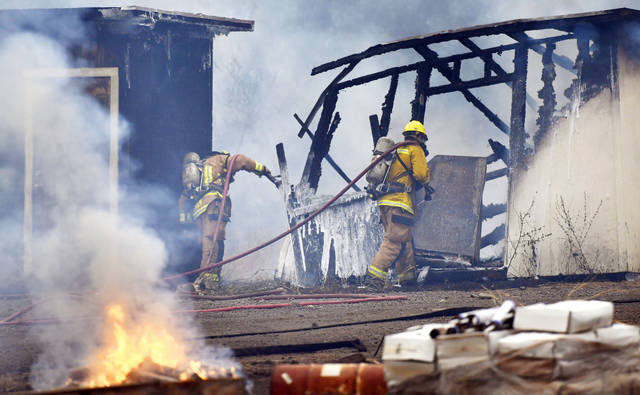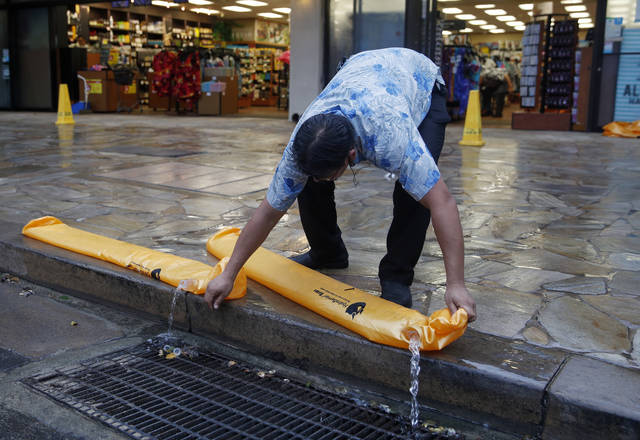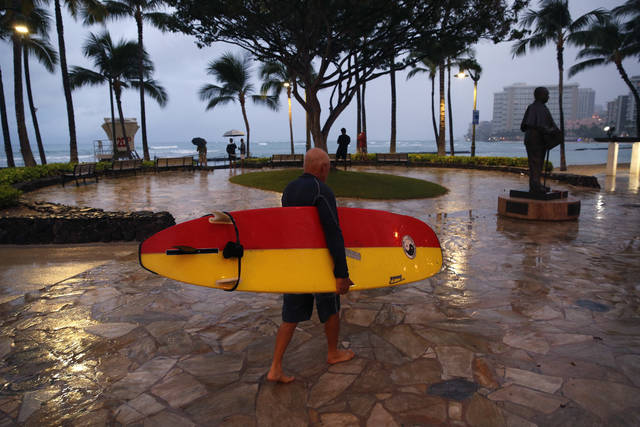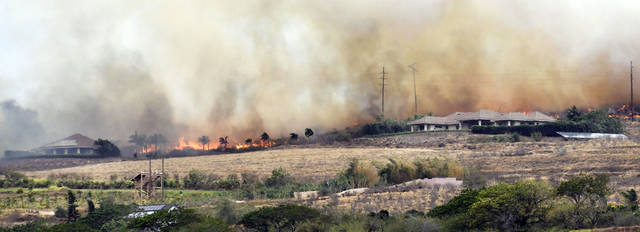HONOLULU — Strong winds have died down but officials warned Saturday that torrential rains remained a big threat to Hawaii after once-powerful Hurricane Lane was downgraded to a tropical storm.
Forecasters said as much as 10 more inches (25 centimeters) of rain could fall on parts of Oahu and Maui as the storm churned about 110 miles (177 kilometers) south of Honolulu, moving north at 3 mph (5 kph).
Though the storm was expected to turn west, which would lessen the threat to the islands, federal authorities urged caution.
“Don’t let your guard down,” Brock Long, administrator of the Federal Emergency Management Agency, said during a telephone briefing in Washington. “Tropical storms can be very dangerous and Hawaii is not in the clear.”
Rain began falling several days ago on the Big Island, which has received nearly 4 feet (1.2 meters) in some areas. Authorities rescued people from more than 20 homes overnight, Hawaii County Managing Director Wil Okabe said, and landslides and pooling water forced the temporary closure of several highways.
The rainfall eased early Saturday.
About 200 miles and several islands to the northwest, along Honolulu’s tourist-heavy Waikiki Beach, some shopkeepers removed plywood from windows in anticipation of reopening.
Tourists wandered the beach and took leisurely swims. Hotels began putting deck chairs back alongside pools. Dozens of surfers were in the Pacific Ocean, riding small waves. The breeze was light.
Winds were also calmer on Maui, which had seen about 12 inches (30 centimeters) of rain and wind gusts up to 50 mph (80 kph). On Saturday, winds were about 11 mph.
Like the Big Island, Maui experienced flooding and landslides, but no storm-related deaths have been reported.
The American Red Cross said more than 1,100 people were staying in shelters, mostly in Oahu. And while the number was down from earlier reports, officials said the figure shows a lot of people are still displaced.
Lane first approached the islands earlier this week as a Category 5 hurricane, meaning it was likely to cause catastrophic damage with winds of 157 mph (252 kph) or above.
But upper-level winds known as shear swiftly tore the storm apart. By Saturday, the National Weather Service said Lane had maximum sustained winds of 60 mph (97 kph).
The outer bands of the hurricane dumped as much as 45 inches (114 centimeters) of rain on the mostly rural Big Island, the Weather Service said. The main town of Hilo, with 43,000 people, was flooded Friday with waist-high water.
As flooding hit the Big Island, winds fanned brush fires that had broken out in dry areas of Maui and Oahu. Some residents in a shelter on Maui had to flee flames, and another fire forced people from their homes.
Flames burned nine homes in the historic coastal town of Lahaina and forced 600 people to evacuate, Maui County spokeswoman Lynn Araki-Regan said. Some have returned, but many have not because much of the area lacks power, Araki-Regan said.
Those outages meant the water provider on Maui’s west side was unable to pump, so officials at the Maui Electric utility urged conservation — particularly important because firefighters need supplies to put out the remaining flames.
In Honolulu’s Waikiki, the man-made Ala Wai Canal was likely to flood if predicted rains arrive, said Ray Alexander of the U.S. Army Corps of Engineers. The canal marks the northern boundary of the Waikiki tourist district.
“The canal has flooded in the past, and I believe it’s safe to say based on the forecast of rainfall it’s likely to flood again — the impacts of which we aren’t prepared to say at this time,” Alexander said.
Major flooding could damage 3,000 structures and cost more than $1 billion in repairs, the Honolulu Star-Advertiser newspaper reported, citing Corps estimates.
The central Pacific gets fewer hurricanes than other regions, with only about four or five named storms a year. Hawaii rarely gets hit. The last major storm to hit was Iniki in 1992. Others have come close in recent years.
———
Brian Skoloff and John Locher in Honolulu; Mark Thiessen in Anchorage, Alaska; Darlene Superville in Washington; and Justin Pritchard in Los Angeles contributed to this report.








